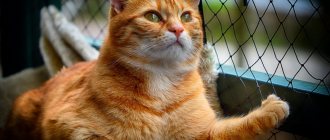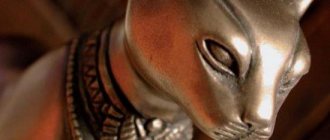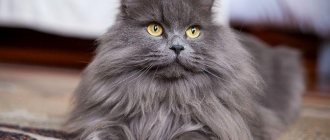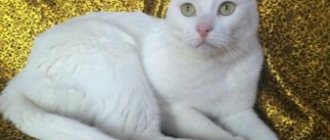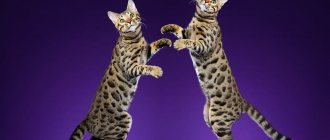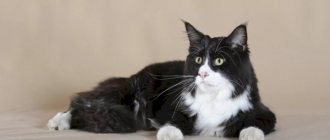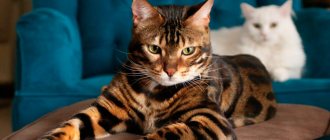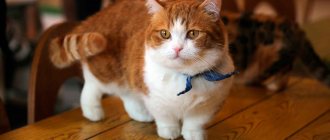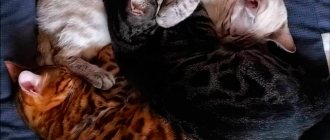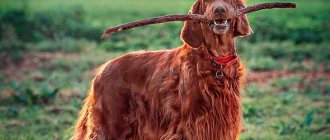Breeds of cats with brindle color
In almost every yard there is a cat or she-cat with a brindle color. Therefore, for many, this color is associated with purebredness. However, in the world everything is completely different and a tiger cat in the house is a sign of wealth, since tabby cats are very popular.
Toyger
Outwardly similar to a tiger. The toyger is a large animal with a muscular build, wide bones, and high shoulders. The head is long, medium in size with small rounded ears. The eyes are brightly colored and round. The upper eyelid is slightly drooping. The nose is long.
According to the standard, a characteristic feature of the toyger is maximum color contrast. Color contrasts are everywhere: between the back and belly, the surface of the ears outside and inside. Vertical, uneven, braided stripes that close in rings on the neck, belly, paws and tail decorate the animal’s fur.
Toygers are calm, flexible, friendly, and sociable. They are smart, easy to learn games and tricks. They love water and swimming. They communicate well with children and other inhabitants of the house.
Toygers are healthy animals. They get heart disease. Prone to obesity. To avoid it, cats are fed dry food twice. There must be natural feeding: chicken breasts, offal, etc. With good care they will live 15 years or more.
There is a nursery in Moscow where these animals are cared for; the cost of a kitten starts from 60 thousand rubles.
Oncilla
Its color and build resembles a jaguar. She has a bright spotted color. She is the size of a regular house cat. Oncilla is a wild animal with a crepuscular lifestyle. Loves to climb trees and swims well. The beast is cruel and aggressive. It's better not to keep him at home. An unusual pet is usually kept in an enclosure.
The character is obstinate, loves loneliness. Activity at night, jumping ability, hunting for small animals cause trouble for the owner.
It is better to feed the animal beef and live food with mineral and vitamin supplements. The animal is fed once a day.
The animal is purchased from a nursery abroad on order. Kitten price starts from $2000.
Bengal cat
Looks like a leopard. This is a large-sized cat with an elongated, muscular body. Their hind legs are longer than their front legs. Thick, silky coat with dense undercoat, patterned with stripes, spots or rosettes. Color ranges from light golden to chocolate brown. Important! The pads on the paws and the tip of the tail are black.
Bengal cats are sociable, playful with a peaceful, affectionate nature. They are attached to their owner and love to walk with him down the street on a leash. Bengals are mobile, active, friendly with children and household members. They like games at heights. Bengals love water and love to swim. There is no need to comb them out.
It is better to feed cats natural food: meat, poultry and dairy products. You can use ready-made premium brand food with all the necessary vitamins. Bengal cats have good health and live up to 15 years.
Kittens cost 35-40 thousand rubles. In Russia there are nurseries in large cities where you can pick up a cheerful, active kitten who is easy to get along with.
Tabby
The color of cats is striped or spotted, similar to a tiger. Animals are calm, affectionate, energetic, and inquisitive.
Tabby cat
Tabbies are homebodies, love solitude, and relax in a secluded corner. They don't need anyone's company. Important! Suitable for single, busy people. They are tolerant of people and domestic inhabitants. Feed 3-4 times a day in small portions, preferably natural products.
There are only two nurseries with this breed in Russia. The price of a kitten ranges from 20 to 70 thousand rubles.
Sokoke
A breed of cat that originated from Kenyan forest cats. Animals of medium size with short hair, muscular, athletic. The color is brown in different shades. Active, love to climb, playful. They keep themselves busy with the game. They do not tolerate low temperatures. It's better to keep them at home. They get along well with children and other animals.
Animals are fed balanced feed with vitamin E and taurine to strengthen the cardiovascular system and improve metabolism. There is only one nursery in Moscow dedicated to this breed. A kitten costs from 30 to 100 thousand rubles.
Savannah
It resembles a cheetah in its color and grace. The famous cheetah spots of different sizes are scattered randomly throughout the fur and body. The color of the spots is brown or black, and the coat is chocolate, golden, brown, silver. The character is active, intelligent, and easy to train. If a Savannah kitten is initially affectionate, sweet and good-natured, then by the age of 3 he can turn into a wild animal. Therefore, it is recommended to keep the pussy in a special enclosure or in the courtyard of a private house.
Appearance
Externally, cats with brindle coloring are very impressive: black stripes or spots adorn the entire body. If you look closely at the photo of these beautiful longhorned beetles, you will notice that they have a rather curious body structure. In general, adult cats and male cats are large, weighing from 6 to 8 kg, have a long thin tail and small paws.
Their muzzle is elongated and has an unusually wide nose. Also, many brindles are characterized by a powerful neck, regular ears and large blue eyes.
Origin of the brindle breed
Tiger cats are a whole genus that includes various breeds. In nature they are predators.
Despite their Latin name (Leopardus), they are not related to leopards.
All representatives of the genus live in the wild in Central and South America. The exact date of origin is unknown, but these representatives of the cat family have existed for a very long time.
For reference! Until recently, all animals of the genus were purebred, but now hybrid forms are being bred.
Health
Typically, wild-type animals are very resilient and disease-resistant, unlike their bred counterparts. Modern genetic studies have shown that the T gene, which determines the brindle color, is directly related to immunity.
Artificially created breeds, more than the descendants of their “wild” counterparts, are susceptible to diseases such as:
- cardiomyopathy;
- cardiac hypotrophy;
- cataract;
- feline leukemia.
The rest of the “tiger cubs” mostly suffer only from the same diseases that ordinary domestic cats suffer from:
- colds;
- infections;
- poisoning
Caring for tiger cats
Tiger cats are not aggressive, but you should always remember their origins and understand that it is unlikely that it will be possible to completely rehabilitate a wild pet.
A cat, like a tiger, will never become a cute, affectionate fluffy cat. These animals cannot be called sociable; during the daytime they prefer to rest in a secluded place, and at night they have a peak of activity. This is an excellent option for owners who are regularly busy at work. At night, tiger beauties run around, have fun, and go about their cat business.
Some breeders keep these expensive cats in special enclosures, where conditions are recreated as close as possible to their real habitat.
Attention! One of the advantages of being wild is that these cats are not particularly fussy about their care.
It is important to provide them with the opportunity to move fully and have plenty of space to play. Therefore, it will not be possible to keep them in a cramped apartment; the best option is a private house with a yard.
Providing the necessary nutritious and varied diet is also an important part of caring for tiger cats. But despite the fact that they are called that way, love and affection can still manifest themselves if all these conditions are met.
Grooming
The soft, smooth fur of tiger cats is quite pleasant to care for. During the shedding season, regular brushing is necessary; on other days, it is enough to remove the fur with a damp palm.
Nutrition
It is not enough to feed a tiger cat with dry food, even premium food; the diet should include daily:
- lean meat (fresh beef is best);
- complex of vitamins and minerals.
You need to feed your cat once a day. Once a week there is a full fasting day. To keep your pet healthy, it requires proper nutrition, care, and regular checkups with a veterinarian.
Price
The tabby color is relatively rare, so “tiger breed” cats are not cheap. The price varies depending on the intensity of color, exclusivity of pattern, breed and pedigree. Experts determine whether the kitten belongs to existing standards.
- Pet class (large deviations from the standard).
- Breed class (minor deviations).
- Show class.
The most expensive are Tigers - up to 120,000 thousand rubles, Scottish Folds - up to 25 thousand rubles, British - up to 10,000 thousand rubles.
And one last thing. If you decide to have a striped friend, remember that these animals really need your attention and love. Don't let them become aggressive and withdrawn.
Features of castration and sterilization
Castration and sterilization of tiger cats is carried out in the same way as similar procedures for representatives of other breeds.
Males are castrated at the age of 6 months to a year, cats are spayed later - from 10 to 14 months. It is possible to perform the procedure at other times, but this should be discussed with a veterinarian on a case-by-case basis.
After surgery, it is worth taking care of the cats by organizing a place for them where they can calmly recover from anesthesia. It should be warm, with soft bedding. There should definitely be bowls of food and water nearby.
You should not disturb the animal during this period, but you need to keep an eye on them regularly, since severe vomiting is likely after anesthesia.
Character of domestic "tigers"
Domestic brindle cats are usually calm, self-sufficient, curious, and love attention and affection. From such cats you cannot hear the usual cat meow. The sounds they make are reminiscent of birds chirping. Kittens are very active, playful, and enjoy communicating with everyone who pays attention to them.
Adult animals are smart, tolerant of children, loyal to their owner, not jealous, and get along with other pets: dogs, cats, birds. The black tiger cat lives a long time, does not need special conditions and feels good in a small room. Its lifespan is about twenty years.
Breeding
If we talk about breeding Siberian cats, then it is quite easy to purchase them in nurseries or from breeders. As for overseas beauties, some breeds can only be found in a few nurseries, and you will have to pay a considerable amount for such exotics.
Toygers cost from 1 to 3 thousand dollars; an individual capable of giving birth to kittens will cost twice as much. They can be bought in official nurseries in Moscow, St. Petersburg, Zelenograd. Mau is not a cheap breed; it costs up to 100 thousand in the official nursery in Moscow. Sokoke, which require quite a lot of care due to health problems, can cost the same price.
The most expensive are Asher cats, the price for them can reach one and a half million rubles or 20-30 thousand dollars if it is a kitten with documents.
The choice of cat depends on your wishes and needs. Purebred animals become a source of pride for many, but they often really need special care and expensive specialized food, since they do not have such good health as the ordinary “murki” that have lived in our country for generations. You need to weigh your options in order to provide your purebred pet with the proper conditions.
An overview of the Toyger cat is presented in the following video:
Basic moments
- The name “toyger” is formed by merging two English words: toy - toy and tiger - tiger.
- Representatives of this breed are smart cats who are quite trainable. They quickly get used to walking on a harness and are able to perform simple acrobatic acts.
- Toygers are tigers only in appearance. By nature, these are quite peaceful and good-natured cats, always ready to join in the game proposed by the owner.
- This is one of the easiest breeds to care for. Toygers shed at a very sluggish pace, which frees the owner from the need to constantly comb the pet and endlessly vacuum the apartment.
- Toygers have no problems with obedience, but if the cat doesn’t like something, he will definitely express his own opinion with a loud meow. As an example: the breed does not like carrier bags and, once inside, the toyger will certainly try to notify others about the infringement of his rights.
- It is believed that the hunting instincts of cats are muted, however, it will not work to make friends with a toyger with a hamster or parrot.
- Toygers do not have a congenital fear of hydrophobia. This is one of those rare breeds for which going to the bathroom is not a tragedy, but an ordinary hygienic procedure.
- Toygers become sexually mature cats at the age of five months, while the psychological and physical maturation of animals is completed only by two years.
A toyger is about five kilograms of striped charm and playfulness that you can’t help but fall in love with. Despite their close relationship with independent Bengals, tiger cats did not resemble their relatives in character. Non-conflict, balanced, sincerely attached to people and home, toygers have every right to be considered, if not ideal, then completely problem-free pets. The breed has only one drawback - the excessive popularity of its representatives among animal lovers. And since increased demand does not always give rise to a high-quality supply, it is still easy to purchase a mixed breed or an unsuccessful breeding product with a lot of external defects under the “domestic tiger” brand.
Historical reference
Try to name the first breed of cats that comes to mind that are very similar to their wild relatives. Bengal? Is not it? The miniature cheetah is the brainchild of California breeder Jane Mill. The “progenitor” of the breed was madly in love with cats and was a first-class biologist-geneticist; the combination of the breeder’s work and hobby allowed the world to see Bengals.
Jane's daughter, Judy Sugden, was interested in her mother's work from a young age and when “the hour struck,” she made a loud statement about her intention to give the world a new breed of cat, a miniature copy of the tiger. Judy officially stated that her “brainchild” will remind people of tigers if the latter disappear from the face of the earth. In working on the breed, the girl used materials received by Jane when breeding Bengal cats.
The first breeder of the breed was the Jamma cat, which resembled a tiger in the shape of its head and ears. By the way, Judy brought Jammu from India in 1993, after which painstaking work began. The first official recognition of the toyger occurred in 2000, and 7 years later, tiger cubs joined the list of breeds of the International Cat Association.
It is worth noting that the breeding work has not yet been completed; every year, breeders (breeders) carry out careful selections and matings in order to reduce the size of the eyes, round the ears, obtain a lighter color on the abdomen, and increase the intensity of the color of the orange stripes. At the stage of formation of the breed, Judy crossed Bengals and Toygers to consolidate physical characteristics, but after the recognition of the tiger cubs, matings were stopped and prohibited. At the moment, there is a scheme that allows you to track the “purity of matings” of Toygers around the world.
Plain (solid)
The color of Scottish Fold cats is monochromatic and they should not have any other color. The fold-eared cat can be of the following colors: white and black, chocolate and lilac, blue and red, cream, fawn and cinnamon. The most popular color in the world among solid Scottish cats is blue. These are the majority of cats.
White
The white Scottish Straight cat can have different eyes, from blue and bright orange to rich amber and copper. Kittens of this variety remain white for the rest of their lives. If kittens have spots, then an adult cat remains white for the rest of its life.
Black
The Scottish Fold black cat is mostly bright in color. A couple of white hairs are acceptable, but if the cat has large red and brown patches, then it is not a purebred.
Black Scottish Fold cats should be bright black in color and their ears, like all fold-eared cats, should be pressed to the head, unlike straight-eared cats. A straight-eared black cat always has its ears erect.
Chocolate
The chocolate Scottish Fold looks impressive. The chocolate color is quite rare. Brown fold kittens should have a smooth, uniform coat of chocolate color. The dark brown coloring adds nobility to the cat.
A brown cat gets this color if he has chocolate, chocolate bicolor or chocolate color points in his pedigree. Chocolate Scottish kittens always delight their owners. They look very cool against a light background.
Lilac (lavender)
A lilac long-eared cat gets this color if he has either lilac color points or lilac in his pedigree. The lilac coloration goes well with orange, copper or amber colored eyes and a light brown nose. This color is also called coffee with milk.
Blue color (blue)
The Scots Blue can have a coat color of many shades of blue. Some cats may have a fur color closer to gray, and some closer to blue. Each hair must be saturated, then the coat will be perfectly blue.
Nutrition
The diet of a domestic predator should be varied, it includes meat and lactic acid products, vegetables, and vitamin supplements. Unable to tolerate a monotonous diet due to their being natural hunters, tiger individuals consume only fresh, nutritious food. Long-haired cats that undergo seasonal shedding require additional care. Frequent bathing is not particularly recommended; animals clean their own fur.
Striped felines have become so close to humans that life without them becomes boring and uninteresting. But it’s not always worth “chasing” a breed. Any stray cat can turn into a gorgeous, handsome cat, feeling the care and affection of its owner.
All kinds of combinations
Spotting or striping may be presented in combination with a solid color. Monochromatic color is usually observed on socks or knee socks, spots on the chest, and stomach. Sometimes the tabby color spreads to the area of the paws, chest, neck, muzzle, and the rest of the coat is monochromatic.
Varieties and their descriptions
The most popular combinations are:
- blue tabby, with a gray or blue pattern on the main light background;
- tabby brown can be seen in the example of the British; cats have a black pattern on a chocolate background;
- Using the example of a Thai cat, you can get acquainted with the unusual seal tabby point color. Cream pets have stripes on the face, tail and paws, as well as light brown points;
- red-silver tabby suggests a base creamy-silver coat color and a reddish pattern on it;
- British kittens with silver fur may have a black tabby pattern;
- silver in combination with gray can also be observed in British cats. Tabby coloring involves a darker pattern on a light background.
Types of tabby patterns
There is a classification of tabby patterns, which includes 4 main types: ticked, striped, classic and spotted. They are also called Abyssinian, mackerel, marbled and leopard, respectively.
Table 1. Tabby color types
| Color name | Ring pattern on neck and tail | Drawings on the torso |
| Ticked | Almost invisible, not pronounced in all breeds. The tip of the tail is predominantly dark | The presence of so-called “freckles”, also faintly expressed |
| Striped | Narrow frequent stripes | Thin stripes, often repeated throughout the body, as well as along the vertebral ridge |
| Classical | Large, not always clearly defined | Wide, uneven stripes with curves, spots, and intermittent areas |
| Spotted | Wide, not very visible, interrupted, open | Spots of varying sizes creating the appearance of broken lines |
Ticked
The most subtle and inconspicuous of all tabby colors. At first glance, it seems that such cats are monochromatic - the pattern is clearly expressed only on the face, paws and tail, but the color of their coat is not uniform. There are light stripes, spots or “freckles” throughout the body, which differ from the main color by only a few tones. Mostly representatives of the Abyssinian breed have a similar color, which is why the ticked color received such a second name.
Ticked is the most inconspicuous of all tabby colors.
Striped
The brindle or mackerel color is characterized by the presence of bright narrow stripes, often repeated throughout the body. This type received its second name due to a certain similarity with the color of mackerel - striped fish. The pattern is clearly defined, often starting at the ridge line, going down to the belly in numerous branches. The color of the stripes clearly contrasts with the main color of the coat.
The mackerel color is clearly visible on the cat's fur.
Classical
Marble pattern is considered one of the most beautiful. Wide linear, spiral or graphic patterns have indistinct outlines on the neck and paws, becoming more pronounced on the back and sides of the animal. The body is often decorated with large spots, curls, uneven patterns, designs reminiscent of human eyes, butterfly wings, and oyster valves. The color of the patterns clearly contrasts with the main tone of the coat, which can be any shade except white.
Marbled Tabby
Spotted
The stripes of spotted cats are practically absent and are intermittent and short. The patterns predominantly consist of successive dots, spots and blots. The color of the patterns is bright, slightly or very different in tone from the main color of the coat. Representatives of this type resemble small leopards.
Spotted tabby color
Rarer variants
Although most tabby cats fall under the above classification, there are many exceptions that do not fit into this classification. In the variety of designs and shapes, one can highlight examples of rare beautiful types:
- rosette Looks like leopard print. The spots are larger, have a clear edge of a darker color in the form of an uneven outline and a lighter center. Both tones are usually different from the base coat color;
- tortoiseshell. The uniqueness of the tortoiseshell tabby is that the main color of the animal is two-color (black and yellow shades, as a rule). The drawing does not have a clear order and is not expressed too clearly;
- calico. A third primary color is added - white (on the paws, chest, tail or muzzle, as a rule). The pattern looks more like spots or short thin stripes. Because of this, the second name for the color is spotted with white;
- patched Combines the characteristics of the two previous subspecies. A cat can be both tri-colored and white and spotted, with very large spots alternating with each other like patches. In each individual spot, both the main color and the color of the pattern change. The color is found predominantly in cats;
- links point. The cat seems to have accents from the drawing. Moreover, only some details are painted (muzzle or ears, tail, paws, chest or spine line).
How to choose a kitten
Important! Only official nurseries have the right to sell toygers. The responsibility for maintaining the purity of the Toyger cat breed is too great. Only dubious establishments that carry out illegal breed mixing can offer to buy such a kitten cheaply.
Before you pick up kittens, you need to familiarize yourself with their pedigree, in which absolutely all representatives must be of the same breed - toyger.
Next, you can begin to examine the baby’s exterior, which can be fully assessed when they are three months old.
It’s good if you have previously studied the color features of the breed and can distinguish it from an ordinary mustachioed-striped yard cat.
The health of the kitten is an important aspect. Once you are sure that this is a real domestic tiger, take a close look at the following:
- evaluate the cleanliness of the ears, nose and eyes;
- the tummy should be soft;
- rashes, redness or peeling of the skin indicate an illness in the baby.
You can separate a kitten from its mother at 2 - 2.5 months
Interesting photo
Calm grace
Yes, it's a tiger, just a small one
After games you need to rest
Before the jump
Handsome Toyger on a green background
Asian tabby
The brindle pattern is found among both short-haired and long-haired felines.
The Asian tabby cat is an animal with an exotic tiger color. The color of the coat can reach gray and silver shades, not at all reminiscent of its predatory counterpart. The formation of kittens' coloration can take from several weeks to two to three months. Purchasing an expensive friend is only possible at a specialized breeding farm upon pre-order.
The cost of a pet depends on the pedigree history, color contrast and characteristic pattern. Belonging to a certain class determines the final price. Pet class with differences from the standard color is estimated at 15-30 thousand rubles, Brit class with minimal errors in the standard - from 30-40 without the right and up to 60-70 thousand with the right to further breeding. Show class is a brindle cat with an ideal pattern and the right to breed. It costs from 80 thousand.
On her neck there is a spot - a necklace, and her eyes and nose with mouth are also outlined. The tail is tapered, with ring-shaped spots.
Painting comes with 4 types of patterns:
- spotted;
- marble (with stripes and stains);
- brindle;
- ticked (with a pattern on the face and striped hairs on the body).
Colors range from blue to cream and chocolate. The ears are erect, the eyes are almond-shaped, the irises are golden, and there are cheekbones. The character is friendly, gentle, communicates with people and other inhabitants of the house.
Leopard-colored cats are a mixture of various breeds, including wild ones. The most important thing in communicating with them is to try to find mutual understanding. A close study of your pet will help you find a common language and create comfort for everyone.
Why a purebred pet?
Choosing a pet is not an easy task. Nowadays it has become popular to purchase purebred cats. Each breed is beautiful and graceful in its own way, plus, with such a cat you can take pride of place at the exhibition. But you shouldn’t judge a cat by its appearance, it should suit your style and lifestyle. The catalog contains a lot of useful information about animals: appearance, temperament, necessary care. Representatives of the Persian and Angora breeds require special care, but they are not so dependent on human interaction. Are you at home most of the time and want some fun? Buy a Siamese or Abyssinian cat. If you have small children at home, you need a pet with a lot of patience in order to withstand all this squeezing. A British or Scottish cat would be a good nanny.
Diversity of the cat world
The world of cats is diverse. They differ in color, eye shape, fur length, character and other equally important criteria. There are a large number of organizations involved in developing standards and registering breeds. How a relationship develops with a pet depends on the person. For a cat, the owner is the most adored person on earth; his betrayal will leave a scar on the animal’s soul. For humans, a cat is a healing salvation from depression and bad mood, a fluffy little ball that can warm the heart on the coldest evenings.
Buy | sell
| Zelenograd29 May 2019 Greencity nursery offers Toyger and Bengal kittens. The babies are raised in the family circle, transferred to the new owner after the necessary… |
| March 10, 2019 Greencity nursery offers Toyger and Bengal kittens. The babies are raised in the family circle, transferred to the new owner after the necessary… |
| 50000 MoscowDecember 14, 2018 The nursery sells the Simona cat of the Toyger breed - one of the very rare breeds in Russia and the world. "Toyger" - translated from English - "toy tiger" ... |
| I'll give it to good handsMoscowJanuary 27, 2018 Moscow and Moscow Region A very young, miniature, smooth-haired Diana, affectionate and tame, purring, wonderful girl. Lives in a cage in a shelter, with a rare… |
| 300 EkaterinburgDecember 14, 2017 Kittens 1.5 months old. . They eat everything. Playful, slightly fluffy, very affectionate, purring. If they grow up to be real hunters in their home. Black boys... |
| I'll give it to good handsEkaterinburgOctober 9, 2016 An active, smart, neat cat offers himself as a healer, sleeping pill, heating pad, performer of musical purrs, master... |
| 100 Tashkent8 October 2015 adorable kittens 1, 5 months old and cats 2 years old, red cat 1 year old. good hunters and friends of man, calming and supporting in difficult times... |
| 25000 September 21, 2015 Affectionate Toyger kittens are looking for their owners. Trained to the tray and scratching post. Active, friendly, playful. The kittens are officially registered... |
| 60000 Moscow8 September 2015 Kittens of the TOYGER breed with the bright appearance of a tiger cub and a sweet, affectionate character are offered by the FairyBerendey nursery. They will become the best comrades in... |
| 30000 September 1, 2015 Toyger kittens for sale in classic (brown) and exotic colors (silver, mink), boys and girls of different ages, vaccinated according to age, ... |
| 60000 Moscow25 April 2015 FairyBerendey nursery offers Toyger kittens and cats. These are bright, cheerful domestic cats. Indoor tiger cubs will delight you and your children... |
| 40000 MoscowNovember 7, 2014 Kittens of the TOYGER breed with a bright tiger cub appearance and a sweet, affectionate character. There are kittens of traditional color and white tiger color. They will become... |
| 55000 St. Petersburg4 June 2014 We offer Toyger kittens from the largest Toyger nursery in Russia. We have kittens of different price categories, call us and we will definitely find you... |
| I will buy May 19, 2014 |
| 77000 Moscow May 15, 2014 Charming Toyger kittens for sale, the babies are 3 months old, they will be ready to move in 2 weeks with all the documents! |
| 1 I'll give it to good hands St. Petersburg July 18, 2013 I’m selling a kitten, from our cat, looks like a toyger (“toy tiger”), 3 months old, litter box trained, eats everything, very active and affectionate. ONLY left... |
| 20000 ObninskFebruary 9, 2013 Wonderful kids are getting ready to move to new homes. There are boys and girls. The children are well-mannered, active, very playful and inquisitive. ... |
| 20000 KalugaFebruary 9, 2013 Wonderful kids are getting ready to move to new homes. There are boys and girls. The children are well-mannered, active, very playful and inquisitive. ... |
| 20000 TulaFebruary 9, 2013 Wonderful kids are getting ready to move to new homes. There are boys and girls. The children are well-mannered, active, very playful and inquisitive. Toygers... |
| December 18, 2010 |
